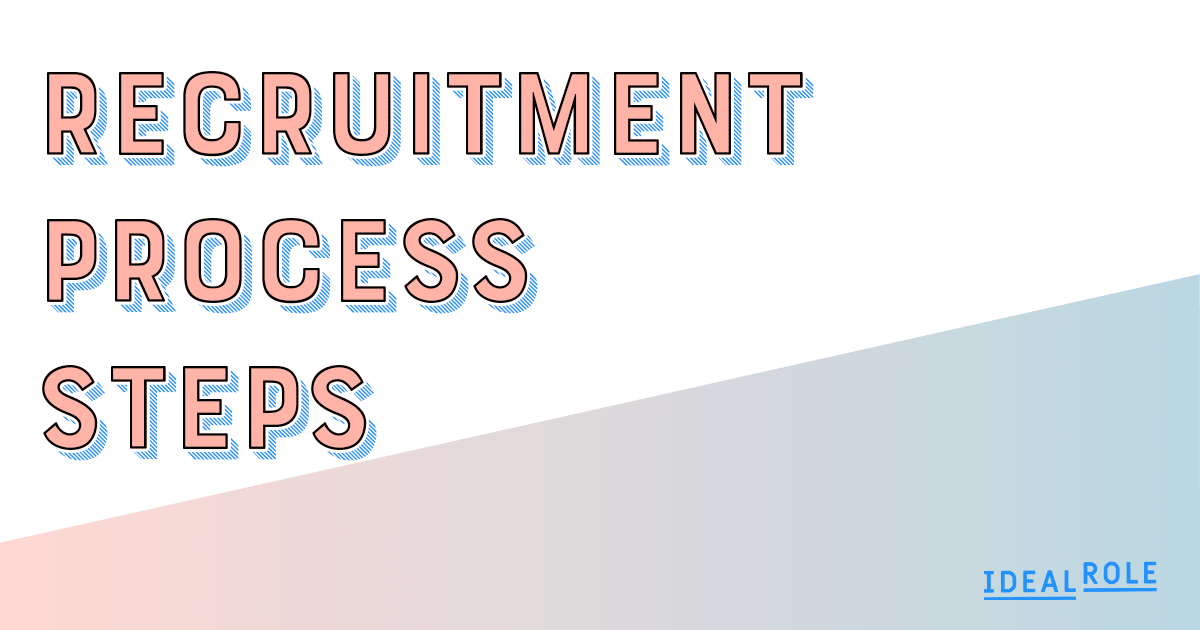Running a successful recruitment process is an incredible way to give candidates an amazing experience, have more offers accepted, save your time and hire quicker.
And if that’s not enough, you’ll also have your hiring managers singing your praises too!
Every time you hire you go through a series of steps to get you from start to finish. These might be the steps in your Applicant Tracking System, or the ones your company has always used.
But are the steps you’re following giving you the results you want? Every single time?
In this post we’re sharing the 8 steps you need to run a successful recruitment process:
1. Identify what you need
Every hire starts with a manager having a need. This could be due to many things, such as having too much work as the company grows. Someone in their team leaving. Or a change in company strategy.
Whatever the reason, the hiring manager needs to list out what they’re trying to achieve. This is not always easy, but you can help them think it through with these questions from Patty McCord, former Netflix Chief Talent Officer:
- What problem are we trying to solve?
- In six months time, if the team was knocking it out of the park with their amazing performance, what would that look like?
- What key metrics need to change from where we are now to get to where we want to be in six months?
- What behaviour is needed? What would people need to know how to do?
- What kind of skills and experience would it take for somebody to know how to do that in order to accomplish your goal?
- Based on the team we have, what areas are we missing?
- Is there someone else that has those skills - or do we need to hire someone with them?
After going through these questions you should have a much clearer idea of the role and what knowledge, skills and abilities the person will need. Then, combined with the approved budget, you should have a good idea of the types of people you’re looking for.
2. Plan what you need to do for this specific role
Now you know the types of people you’re looking for, you need to plan how you’ll find them and how you’ll work out who is the best person to hire.
Firstly, what job titles do they usually have? Where do they hang out online? What interests them?
Essentially you want to work out how you’ll reach these people and appeal to them. If you’re lucky enough to have someone on your team that’s like the person you’re looking for, ask them how they’d find out about your job - and what would make them want to apply.
Next, plan out the steps you’ll need to decide who to hire:
- Will there be a phone screen?
- How many interviews will you need? Where will they be? And who will be in them?
- Are you using any assessment?
- How will you judge people to find the best person for the role?
We’ll go over these steps in more detail below. As we go through them it’s a good idea to note down which ones you’ll need. And if you can, start thinking about who will be responsible for each task so that everyone is clear on what they’re doing.
3. Write the job description
It’s important to remember that in reality the job description is an ad. It’s one of the main things people will use to decide whether to apply for your job, so it needs to sell the role and your company.
Not sure how to get your job ads to stand out and get the right people to apply?
Use copywriting - the art of writing text for advertisements and publicity materials.
But a word of caution - when writing your job descriptions be selective in what you put in the requirements. Many companies use this section to list out every possible thing their dream candidate has. Don’t.
After the headline/job title, many people check the job requirements section before deciding whether to read the rest of the job description. The more items you add the more chance there will be that someone reading it will think they don’t qualify. So stick with what the person must have and get rid of the rest.
It’s also worth checking that the words you use appeal to both men and women as some language can be gendered. For example, words like ‘aggressive’ and ‘decisive’ tend to appeal to men. Whereas ‘cooperative’ and ‘responsive’ get a better response from women.
However, when there are too many masculine words, women are likely to be subconsciously turned off and not apply. So it’s best to replace gendered words with a neutral equivalent. Like swapping ‘’ for ‘’.
Textio is probably the most advanced way to do this, but comes at a cost. But you can find free, but simpler, versions.
4. Find people to apply for your job
Back in step 1, there was a question asking whether anyone in your company would be a good fit for the job. If you haven’t already checked, do it now. You could save yourself a lot of extra work!
If there isn’t someone in your company that can do the job, you’ll need to use the information you gathered in step 2 to find people.
First off, you should add the job to your career site. Your career site is the centre of your recruitment funnel - all paths lead here so make sure the job is up and can be found.
Before you start advertising, there are two places you should check and one thing you need to do:
- Check your talent pipeline - is there anyone that’s previously said they’d like to work at your company that would be suitable?
- Check with your current employees, especially anyone working in a similar role, and ask them to reach out to people they know that may be interested. And remember to tell them about any referral fee they can earn 😉.
- Make sure you’ve set up an automated email that thanks everyone that applies through your application form and lets them know how long till you’ll get back to them.
Based on where your target people are likely to be, and your budget, you can start advertising the job. This could be on job boards, social media or industry specific sites.
Many Applicant Tracking Systems (ATS) can do this for you - just be sure to check how the ads look before you publish them. You want to make sure the title and preview text, if there is any, catch people’s attention and make them want to click to see the full job ad.
And depending on how many people there are with the right knowledge, skills and abilities, you may need to directly source candidates by reaching out to them individually.
5. Review the applications
Hopefully you’re now starting to get some applications coming in!
Now you’ll need to review each application and decide whether to advance them to the next step. You can do this using the skills, knowledge and abilities you listed out in step 1, and the criteria to judge them from step 2.
Before rejecting anyone, think about whether they’d be good for other roles you may have open or coming up in the future. If they could be a good fit for something else, add them to your talent pipeline.
Then contact everyone to let them know if you want to interview them or not (step 6).
Although no one likes giving bad news, it’s worth letting people know when you don’t want to interview them. You never know where this person will be in a few years time, and that courtesy you showed them may make a difference when you want to speak to them.
6. Interview and assess people
Depending on your plan, this step can include phone or video screening calls, a number of interviews and formal assessments.
For each of these there are five sub-steps that you’ll need to do for each candidate:
- Schedule a time
- Conduct the interview or have the candidate complete the assessment
- Score the results
- Decide if you want the person to continue to the next round.
- Notify them of your decision.
To get the best results from your interviews, you should use a structured approach. This means asking each person the same questions in the same order, and grading their answers with a standard scoring system. Structured interviews are one of the best ways to predict how well someone will perform in a job.
Another best-practice is to have a diverse mix of people performing the interviews. The different perspectives of the interviewers can help to balance out their unconscious biases, making for a fairer and more accurate process.
At these later stages in your process, candidates will have invested a significant amount of time. You should bear this in mind when they won’t be progressing. Let them know as soon as you can, and providing useful feedback for their next interview can help leave a good impression of you and your company.
Finally, if you get to this stage and find you’re not happy with the people you’re interviewing, you should stop and work out why:
- Are you looking for the right person (step 1)?
- Are your job ads attracting the wrong people (step 3)?
- Is there a better way to find the people you’re looking for (step 4)?
7. Decide who to hire and make an offer
So, you’ve finished all of the interviews and assessment, and know who you want to hire.
Now it’s time to give someone the good news and make them an offer!
Hopefully you’ve discussed salary, start date, working options and all of those other details before this stage and the offer meets their expectations. Once accepted, you’ll need to prepare and send them the employment contract, and complete any reference checks you need.
8. Onboarding
Given all the effort you’ve put in to get this far, you want to make sure that the person you hire feels welcome when they start - and that they stay around.
Like in all the other steps, the best way to do this is to think about it from your new employee’s perspective. What do they need? What do they want? And what can you do to make them feel special?
Your onboarding may change depending on the role and person, but some of the things to consider are:
- Keeping in touch before they start to make them comfortable and excited for their first day.
- Making sure they know where to arrive and that someone will be there to meet them.
- Having all their equipment ready and set up before they arrive.
- Show them around the office and introduce them to the team.
- Arranging any training they’ll need. Along with standard orientation this could include training on the tools you use (they may be different to what they used in the past).
- Give them as much information about their team and department as you can. Things like; who does what, where their role fits in, objectives, goals and how they’ll be measured.
- Similarly, discuss their objectives and agree how and when they’ll receive and provide feedback and support.
Congratulations, you’re all done!
This may seem like a lot at first, but the more you do the 8 steps the easier they’ll get. And the better your recruitment process will be.
Ready to start mapping out your recruitment process?
👉 Check out our post on creating your recruitment process flowchart.




